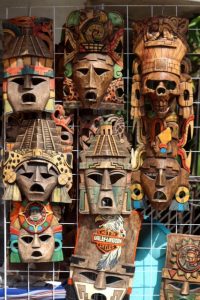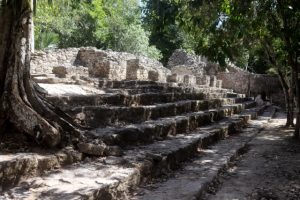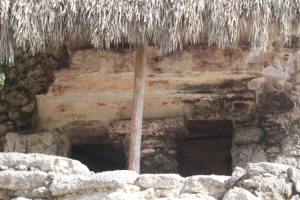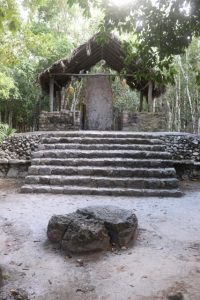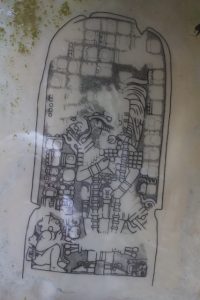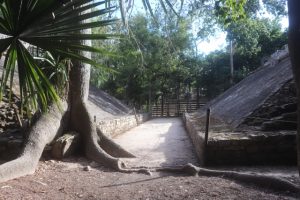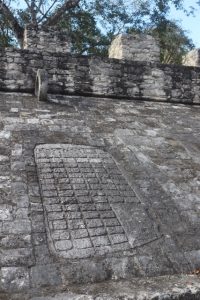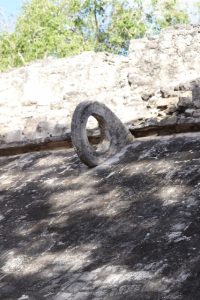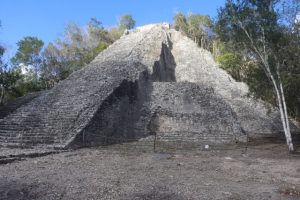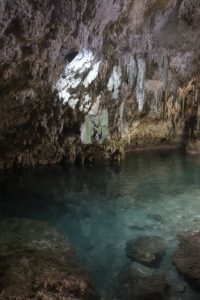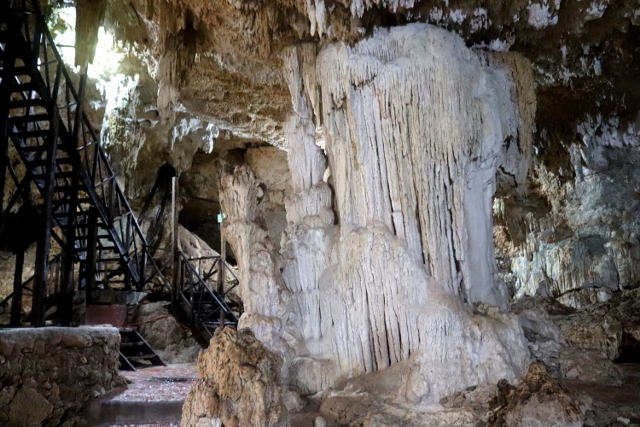We have set up base in Coba, a little inland from the Costa Maya, with Tulum as its centre. Tulum is three things: a coastal zone full of beach hotels, an archaeological site, and the ‘pueblo’ a bit further back from the shore. We had been in Tulum for lunch, and to change money – we had run out of cash after having been robbed – literally – by the police earlier. Which made us decide to avoid Tulum all together.
Well, almost. We still wanted to see the Tulum ruins, apparently picturesque against the background of the Caribbean Sea, so we left our base early the next day, to be at Tulum at around nine am. To beat the crowds. Right! If we had thought that our confrontation with tourism had started in Chacchoben, we need to think again. When we arrived, there was already a line of hundreds of meters for the ticket office. And, as far as I understand, Tulum is a pretty small site. Do we really need to see ruins together with all these people, probably obscuring the view, and most definitely obscuring my pictures? We turned around and left.
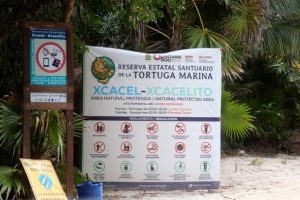
these are all the things you are NOT allowed to do – and some you are allowed to do – at the Xcacel turtle reserve and beach
Off to our next program item, a tiny little secret beach mentioned in the Lonely Planet. A ‘contradiction in terminus’, I know, everybody reads the LP in the expectation to find that last undiscovered secret, and thus it will be overpopulated in now time. But no, when we arrived at the Xcacel beach we were the only ones, and although later more people joined, it remained the type of beach you expect from a little secret. No facilities except for some toilets, a parking, and two wooden tables in the parking where you can eat the food you brought yourself; which is not allowed on the beach, neither is any form of plastic, alcohol, stereos, and a whole lot more. This is a turtle sanctuary, and large parts have been cordoned off to protect them. I suspect the fee we pay is to support the sanctuary work, but at the same time they want to ensure the environmental integrity for those turtles. Great concept, and it works for us. White beach, clear sea water, and protected by a reef not far away, within reach of a swim. With fins and snorkel, to admire some of the corals and fishes – not as spectacular as in Haiti, across the Caribbean some years ago, but a nice enough activity for a long morning. By the time it gets too hot, we pack up our stuff and leave again, from the still remarkably underpopulated beach. So much for the tourist trap.
We head back to Coba, not to our hotel, but to the archaeological site there, a large complex and once an important trading centre, from 600-1100 AD approximately – which is quite late, in Maya terms. Back into the trap. But it looks worse than it is, there are lots of large busses parked, but by the time we get in, halfway the afternoon, most of the big groups are leaving again. Most of the small groups, too, it looks, and at most of the buildings there are in fact very few other people. This site contains two – presumably restored – ball courts, of the type we have seen often in Guatemala, long ago. And indeed, architecturally, the site here resembles more that of Peten in Guatemala than that of Northern Yucatan, or so the text boards say. There is also a corner full of stelae, nine of them, most badly weathered. Yet from some you can actually still make out some of the figures, which is helped by detailed drawings that have been placed next to them. Others are completely undecipherable, which is probably the reason that these are not being accompanied by drawings. The highlight, though, is the large Nohoch Mul pyramid, once again forbidden to climb, but impressive enough to admire from below.
Nearby we had identified several attractive cenotes. Cenotes are sinkholes in the carbonate bedrock that underlays much of Yucatan peninsula, caused by the collapse of the surface layer. There are hundreds of cenotes here, some well-developed for tourist activity, including jumping platforms and ziplines, and bars and restaurants. Local boat tours take you to underground rivers, and to other cenotes. Other locations are more introvert, just a blue hole in the ground, where you can swim a bit, or put your snorkel on to inspect the underwater life: apparently, there is a fish that occurs in all the cenotes in Yucatan. Nicer even, sometimes the collapse has occurred in the subsurface, with creates a covered sinkhole, like the Choo Ha cenote we visited. Steep wooden stairs take you to perhaps 30 meters below the surface, where a spectacular underground lake, a bit chilly, invites you for a dip. After which you can float on your back through the cave, admiring the stalactites that hang from the ceiling. Oh, and at the end of the afternoon we were all on our own, in this magic place.
